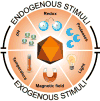Stimulus-responsive viral vectors for controlled delivery of therapeutics
- PMID: 28842318
- PMCID: PMC5723212
- DOI: 10.1016/j.jconrel.2017.08.021
Stimulus-responsive viral vectors for controlled delivery of therapeutics
Abstract
Virus-based therapies have gained momentum as the next generation of treatments for a variety of serious diseases. In order to make these therapies more controllable, stimulus-responsive viral vectors capable of sensing and responding to specific environmental inputs are currently being developed. A number of viruses naturally respond to endogenous stimuli, such as pH, redox, and proteases, which are present at different concentrations in diseases and at different organ and organelle sites. Additionally, rather than relying on natural viral properties, efforts are underway to engineer viruses to respond to endogenous stimuli in new ways as well as to exogenous stimuli, such as temperature, magnetic field, and optical light. Viruses with stimulus-responsive capabilities, either nature-evolved or human-engineered, will be reviewed to capture the current state of the field. Stimulus-responsive viral vector design considerations as well as gaps in current research efforts will be identified.
Keywords: Bioactivatable; Bioresponsive; Gene delivery; Gene therapy; Viral vector.
Copyright © 2017 Elsevier B.V. All rights reserved.
Figures








References
-
- Cicalese MP, Ferrua F, Castagnaro L, Pajno R, Barzaghi F, Giannelli S, Dionisio F, Brigida I, Bonopane M, Casiraghi M, Tabucchi A, Carlucci F, Grunebaum E, Adeli M, Bredius RG, Puck JM, Stepensky P, Tezcan I, Rolfe K, De Boever E, Reinhardt RR, Appleby J, Ciceri F, Roncarolo MG, Aiuti A. Update on the safety and efficacy of retroviral gene therapy for immunodeficiency due to adenosine deaminase deficiency. Blood. 2016;128:45–54. doi: 10.1182/blood-2016-01-688226. - DOI - PMC - PubMed
-
- Reach T. FDA Approves First Oncolytic Virus Therapy: Imlygic for Melanoma. Oncol. Times. 2016;37:36. doi: 10.1097/01.COT.0000475724.97729.9e. - DOI
Publication types
MeSH terms
Substances
Grants and funding
LinkOut - more resources
Full Text Sources
Other Literature Sources

